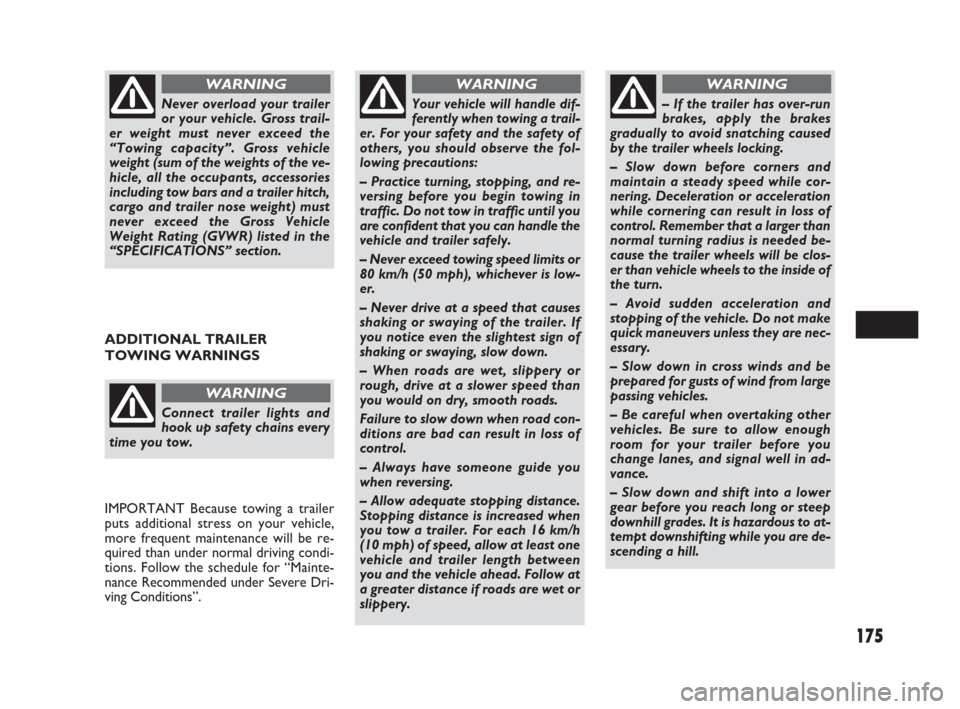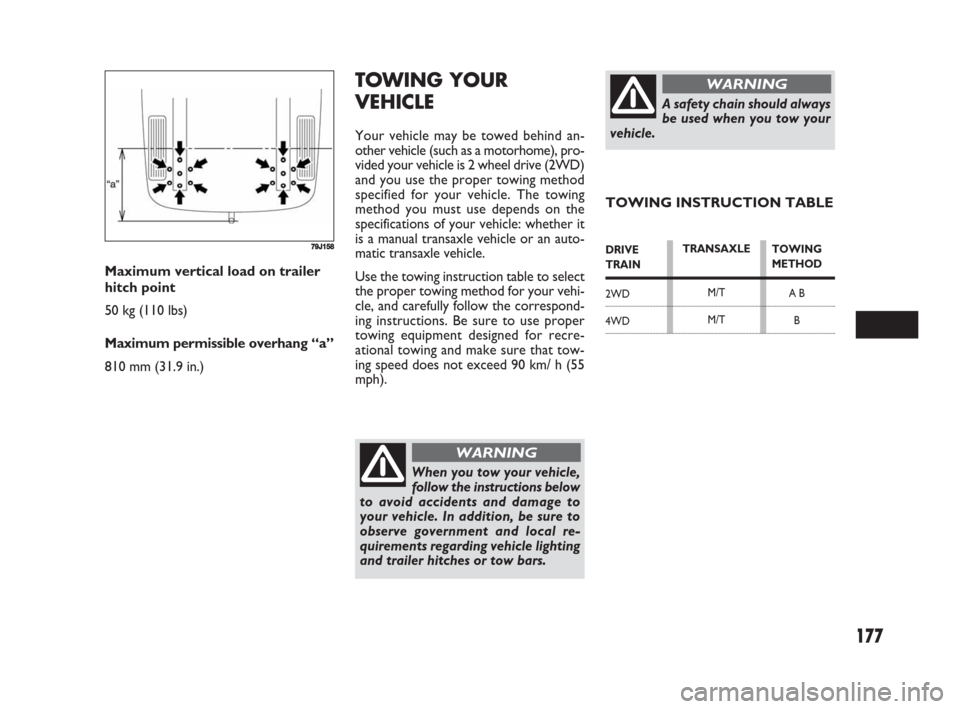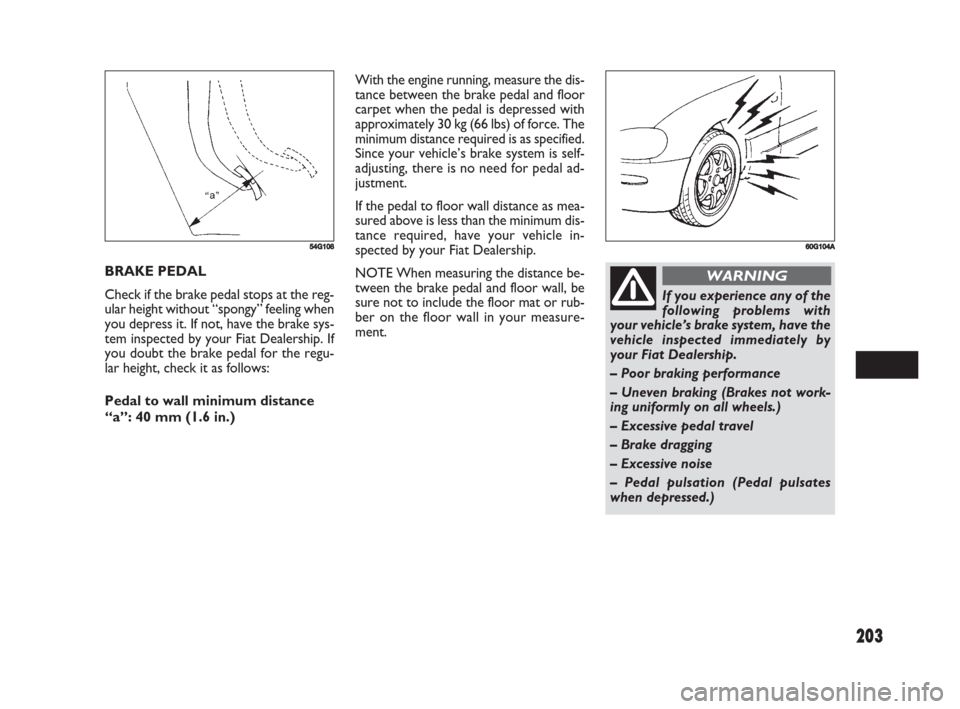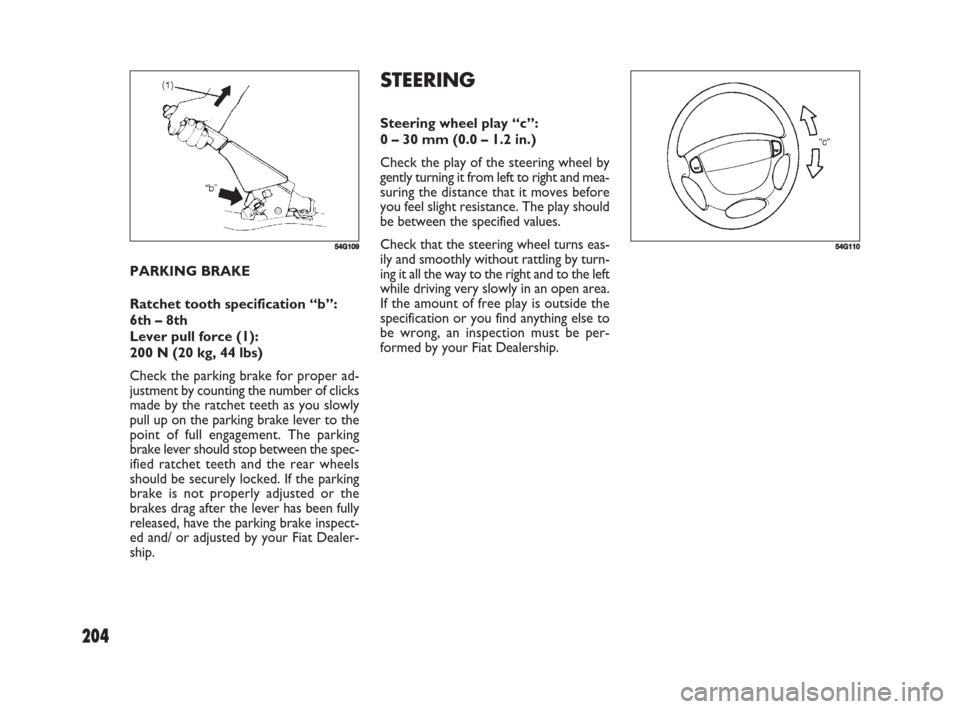Page 176 of 266

175
ADDITIONAL TRAILER
TOWING WARNINGS
Never overload your trailer
or your vehicle. Gross trail-
er weight must never exceed the
“Towing capacity”. Gross vehicle
weight (sum of the weights of the ve-
hicle, all the occupants, accessories
including tow bars and a trailer hitch,
cargo and trailer nose weight) must
never exceed the Gross Vehicle
Weight Rating (GVWR) listed in the
“SPECIFICATIONS” section.
WARNING
Connect trailer lights and
hook up safety chains every
time you tow.
WARNING
IMPORTANT Because towing a trailer
puts additional stress on your vehicle,
more frequent maintenance will be re-
quired than under normal driving condi-
tions. Follow the schedule for “Mainte-
nance Recommended under Severe Dri-
ving Conditions”.
Your vehicle will handle dif-
ferently when towing a trail-
er. For your safety and the safety of
others, you should observe the fol-
lowing precautions:
– Practice turning, stopping, and re-
versing before you begin towing in
traffic. Do not tow in traffic until you
are confident that you can handle the
vehicle and trailer safely.
– Never exceed towing speed limits or
80 km/h (50 mph), whichever is low-
er.
– Never drive at a speed that causes
shaking or swaying of the trailer. If
you notice even the slightest sign of
shaking or swaying, slow down.
– When roads are wet, slippery or
rough, drive at a slower speed than
you would on dry, smooth roads.
Failure to slow down when road con-
ditions are bad can result in loss of
control.
– Always have someone guide you
when reversing.
– Allow adequate stopping distance.
Stopping distance is increased when
you tow a trailer. For each 16 km/h
(10 mph) of speed, allow at least one
vehicle and trailer length between
you and the vehicle ahead. Follow at
a greater distance if roads are wet or
slippery.
WARNING
– If the trailer has over-run
brakes, apply the brakes
gradually to avoid snatching caused
by the trailer wheels locking.
– Slow down before corners and
maintain a steady speed while cor-
nering. Deceleration or acceleration
while cornering can result in loss of
control. Remember that a larger than
normal turning radius is needed be-
cause the trailer wheels will be clos-
er than vehicle wheels to the inside of
the turn.
– Avoid sudden acceleration and
stopping of the vehicle. Do not make
quick maneuvers unless they are nec-
essary.
– Slow down in cross winds and be
prepared for gusts of wind from large
passing vehicles.
– Be careful when overtaking other
vehicles. Be sure to allow enough
room for your trailer before you
change lanes, and signal well in ad-
vance.
– Slow down and shift into a lower
gear before you reach long or steep
downhill grades. It is hazardous to at-
tempt downshifting while you are de-
scending a hill.
WARNING
171-180 Fiat16 New GB 3-09-2008 8:42 Pagina 175
Page 177 of 266

176
– Avoid “riding” the brakes.
This could cause the brakes
to overheat resulting in reduced brak-
ing efficiency. Use engine braking as
much as possible.
– Because of the added trailer weight,
your engine may overheat on hot
days when going up long or steep
hills. Pay attention to your engine
temperature gauge. If it indicates
overheating, pull off the road and
stop in a safe place. Refer to “If the
Engine Overheats” in “EMERGENCY
SERVICE” section.
WARNING
60A186
When parking your vehicle
and connected trailer, al-
ways use the following procedure:
– Apply the vehicle’s brakes firmly.
– Have another person place wheel
chocks under the wheels of the vehi-
cle and the trailer while you are hold-
ing the brakes.
– Slowly release the brakes until the
wheel chocks absorb the load.
– Fully engage the parking brake.
– Manual Transaxle – Shift into Re-
verse or first gear and turn off the en-
gine.
WARNING
When starting out after
parking:
– Depress the clutch and start the en-
gine.
– Shift into gear, release the parking
brake, and slowly pull away from the
chocks.
– Stop, apply the brakes firmly and
hold them.
– Have another person remove the
chocks.
WARNING
171-180 Fiat16 New GB 3-09-2008 8:42 Pagina 176
Page 178 of 266

177
TOWING YOUR
VEHICLE
Your vehicle may be towed behind an-
other vehicle (such as a motorhome), pro-
vided your vehicle is 2 wheel drive (2WD)
and you use the proper towing method
specified for your vehicle. The towing
method you must use depends on the
specifications of your vehicle: whether it
is a manual transaxle vehicle or an auto-
matic transaxle vehicle.
Use the towing instruction table to select
the proper towing method for your vehi-
cle, and carefully follow the correspond-
ing instructions. Be sure to use proper
towing equipment designed for recre-
ational towing and make sure that tow-
ing speed does not exceed 90 km/ h (55
mph). Maximum vertical load on trailer
hitch point
50 kg (110 lbs)
Maximum permissible overhang “a”
810 mm (31.9 in.)
When you tow your vehicle,
follow the instructions below
to avoid accidents and damage to
your vehicle. In addition, be sure to
observe government and local re-
quirements regarding vehicle lighting
and trailer hitches or tow bars.
WARNING
A safety chain should always
be used when you tow your
vehicle.
WARNING
TOWING INSTRUCTION TABLE
DRIVE TRAIN
2WD
4WDTOWING
METHOD
A B
B TRANSAXLE
M/T
M/T
79J158
171-180 Fiat16 New GB 3-09-2008 8:42 Pagina 177
Page 179 of 266
178
A: 2WD VEHICLES WITH
MANUAL TRANSAXLE
❒Secure the front wheels on a towing
dolly according to the instructions pro-
vided by the dolly manufacturer.
❒Release the parking brake.
75J019
TOWING METHOD A
FROM THE FRONT:
FRONT WHEELS ON A DOLLY
AND REAR WHEELS ON THE GROUND
171-180 Fiat16 New GB 3-09-2008 8:42 Pagina 178
Page 180 of 266
179
79J130
TOWING METHOD B
FROM THE FRONT:
FOUR WHEELS ON THE GROUND
B: 2WD VEHICLES WITH
MANUAL TRANSAXLE
❒Shift the manual transaxle lever into
neutral.
❒Turn the ignition key to the “ACC” po-
sition to unlock the steering wheel.
❒Release the parking brake.
IMPORTANT The steering column is not
strong enough to withstand shocks trans-
mitted from the front wheels during tow-
ing. Always unlock the steering wheel be-
fore towing.
B: 4WD VEHICLES WITH
MANUAL TRANSAXLE
❒Shift the 2WD/4WD switch to the
“2WD” mode.
❒Shift the manual transaxle lever into
neutral.
❒Turn the ignition key to the “ACC”
position to unlock the steering wheel.
❒Release the parking brake.
IMPORTANT The steering column is
not strong enough to withstand shocks
transmitted from the front wheels dur-
ing towing. Always unlock the steering
wheel before towing.
IMPORTANT Never use a towing truck
to tow 4WD vehicles.
79J17579J176
171-180 Fiat16 New GB 3-09-2008 8:42 Pagina 179
Page 189 of 266

188
RReplace or Change
IInspect and correct or replace if necessary
LLubricate Severe condition code
ARepeated short trips
BDriving on rough and/or muddy roads
CDriving on dusty roads
DDriving in extremely cold weather and/ or salted roads
ERepeated short trips in extremely cold weather
FLeaded fuel use
HTrailer towing (if admitted)
MAINTENANCE RECOMMENDED UNDER SEVERE DRIVING CONDITIONS
If the vehicle is usually used under the conditions corresponding to any severe condition code given below, it is recommended that
applicable maintenance operation be performed at the particular interval as given in the chart below.
Severe Condition Code
B C D
AD
A C D E F H
A C D E H
A B C E F H
C
B C D H
B D E H
B E H
Maintenance Interval
Every 15,000 km (9,000 miles) or 12 months
Every 45,000 km (27,000 miles) or 36 months
Every 48 months
Every 7,500 km (4,500 miles) or 6 months
Every 7,500 km (4,500 miles) or 6 months
Every 30,000 km (18,000 miles) or 24 months
Every 10,000 km (6,000 miles) or 8 months
Every 30,000 km (18,000 miles) or 24 months
Every 15,000 km (9,000 miles) or 12 months
Every 15,000 km (9,000 miles) or 12 months
First time only: 15,000 km (9,000 miles) or
12 months
Second time and after: Every 30,000 km
(18,000 miles) or 24 months reckoning from
0 km (0 mile) or 0 month Maintenance
Accessory drive belt (V-belt)
Timing belt (Diesel versions)
Engine oil and oil filter (Petrol versions)
Engine oil and oil filter (Diesel versions)
Spark plugs
Air cleaner cartridge
(Check and replace more frequently, if required)
Wheel bearings
Driving axle /Propeller shaft casing (4WD)
Manual transaxle gear oil
Transmission unit oil (4WD)
Differential oil (4WD)Maintenance
Operation
I
R
R
R
R
R
R
R
I
I
R Iridium plugs (recommended)
Nickel plugs (traditional)
181-224 Fiat16 New GB 3-09-2008 8:17 Pagina 188
Page 204 of 266

203
With the engine running, measure the dis-
tance between the brake pedal and floor
carpet when the pedal is depressed with
approximately 30 kg (66 lbs) of force. The
minimum distance required is as specified.
Since your vehicle’s brake system is self-
adjusting, there is no need for pedal ad-
justment.
If the pedal to floor wall distance as mea-
sured above is less than the minimum dis-
tance required, have your vehicle in-
spected by your Fiat Dealership.
NOTE When measuring the distance be-
tween the brake pedal and floor wall, be
sure not to include the floor mat or rub-
ber on the floor wall in your measure-
ment. BRAKE PEDAL
Check if the brake pedal stops at the reg-
ular height without “spongy” feeling when
you depress it. If not, have the brake sys-
tem inspected by your Fiat Dealership. If
you doubt the brake pedal for the regu-
lar height, check it as follows:
Pedal to wall minimum distance
“a”: 40 mm (1.6 in.)
54G10860G104A
If you experience any of the
following problems with
your vehicle’s brake system, have the
vehicle inspected immediately by
your Fiat Dealership.
– Poor braking performance
– Uneven braking (Brakes not work-
ing uniformly on all wheels.)
– Excessive pedal travel
– Brake dragging
– Excessive noise
– Pedal pulsation (Pedal pulsates
when depressed.)
WARNING
181-224 Fiat16 New GB 3-09-2008 8:18 Pagina 203
Page 205 of 266

204
STEERING
Steering wheel play “c”:
0 – 30 mm (0.0 – 1.2 in.)
Check the play of the steering wheel by
gently turning it from left to right and mea-
suring the distance that it moves before
you feel slight resistance. The play should
be between the specified values.
Check that the steering wheel turns eas-
ily and smoothly without rattling by turn-
ing it all the way to the right and to the left
while driving very slowly in an open area.
If the amount of free play is outside the
specification or you find anything else to
be wrong, an inspection must be per-
formed by your Fiat Dealership. PARKING BRAKE
Ratchet tooth specification “b”:
6th – 8th
Lever pull force (1):
200 N (20 kg, 44 lbs)
Check the parking brake for proper ad-
justment by counting the number of clicks
made by the ratchet teeth as you slowly
pull up on the parking brake lever to the
point of full engagement. The parking
brake lever should stop between the spec-
ified ratchet teeth and the rear wheels
should be securely locked. If the parking
brake is not properly adjusted or the
brakes drag after the lever has been fully
released, have the parking brake inspect-
ed and/ or adjusted by your Fiat Dealer-
ship.
54G10954G110
181-224 Fiat16 New GB 3-09-2008 8:18 Pagina 204